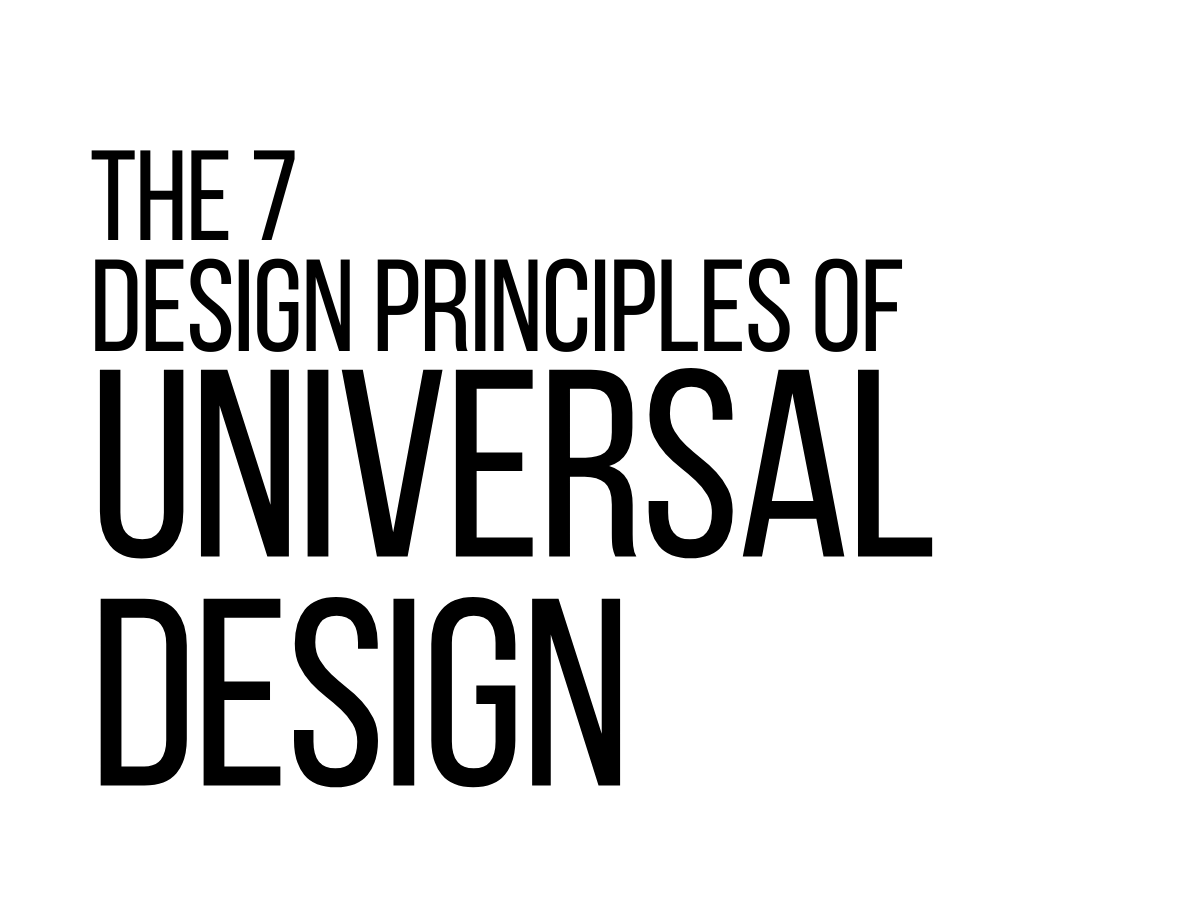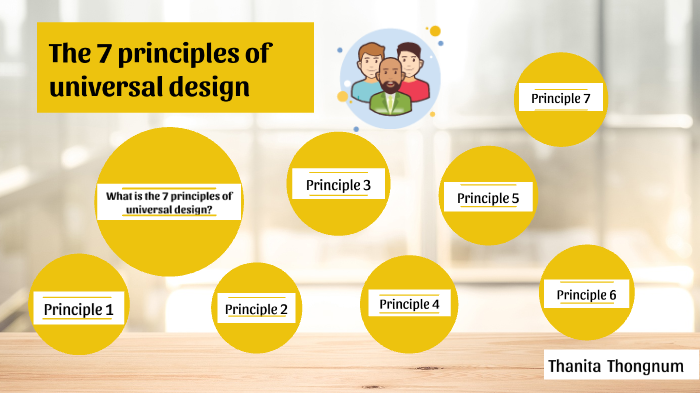Universal Design: Process, Principles, and Applications DO-IT
Table Of Content

The Center for Applied Special Technology (CAST) created a set of three principles with roots in cognitive neuroscience to underpin practices and curriculum for teaching and learning. Three sets of principles provide guidance for applying universal design regardless of the scope. The design communicates necessary information effectively to the user, regardless of ambient conditions or the user's sensory abilities. In his quest for a more inclusive world, Ronald explored the concept of accessible design, where environments are open for everyone to access, regardless of their abilities. The design can be used efficiently, comfortably, and with a minimum of fatigue. For example, an automatic door opener can facilitate access to an office space or classroom.

Inclusive by Design: 3 Examples of Digital Accessibility
When you provide flexibility and high discoverability, you empower your users. They’ll be able to personalize their experiences based on their unique needs. These seven principles may be applied to evaluate existing designs, guide the design process, and educate both designers and consumers about the characteristics of more usable products and environments. Although UD has its roots in the design field of architecture and commercial products and information technology (IT), applications in education are growing in number. UD can provide a philosophical framework for the design of all products and environments at all education levels—including technology, teaching and learning activities, academic spaces, student services and professional meetings.

The 7 Factors that Influence User Experience
These can include features such as adjustable font sizes, customizable color themes, and multiple navigation options. This is where those UX design principles and design patterns come in. So, create handy features, nice-to-haves, and redundant ways of achieving goals. Make sure you do it effectively to the users, though, so that these are obvious.
Communications & Digital
The story starts where, in the late 20th century, an architect named Ronald Mace had an idea. Ronald, who was confined to a wheelchair due to polio, faced the challenges of navigating a world not adequately designed to accommodate the wide range of human abilities. This website is using a security service to protect itself from online attacks. There are several actions that could trigger this block including submitting a certain word or phrase, a SQL command or malformed data.
Yet, while the two terms are often used interchangeably, universal design and inclusive design aren’t synonymous. On the one hand, the goal of universal design is to serve as many people as possible by arriving at a single design solution—a goal that inevitably leaves out some users. On the other, the goal of inclusive design is to create designs that won’t exclude or marginalize anyone, which means sometimes more than one solution will be provided to accommodate different users.
Consider factors such as age, ability, gender, race, ethnicity, and language preferences. You should be able to empathize with different user perspectives and design accordingly with them. Ron Mace, who coined the term “universal design,” advocated for the design of environments that all individuals can access, regardless of their abilities.
Use of the design is easy to understand, regardless of the user’s experience, knowledge, language skills, or current concentration level. For example, a website that is well-organized with clear headings will facilitate access to information. The design accommodates a wide range of individual preferences and abilities.
That way, you can gather valuable feedback and identify potential usability issues. For example, does your design communicate necessary information effectively? Do users who find your design difficult share common characteristics?
General Recreation: The Evolution of Playground Design - VISTA.Today
General Recreation: The Evolution of Playground Design.
Posted: Wed, 29 Jun 2022 07:00:00 GMT [source]
Edward Steinfeld, director of the Idea Center at the University of Buffalo, will be leading this initiative. Invest in universal design to transform the way your agency serves citizens, regardless of ability, and create tools and products that are easier for everyone to use. It’s about developing solutions to meet the needs of all users, with and without disabilities. Universal design, a concept now widely used in the private sector, provides a path for federal agencies to shift to this broader focus.
Characteristics of any UD product or environment are that it is accessible, usable, and inclusive. Tolerance for error is the fifth universal design principle, and it states that a design should minimize dangers and the adverse results of unintended activities. This principle is meant to minimize hazards through design and create certain procedures such as warning of hazards, and fail-safe features and discourage unconscious action where full concentration is needed.
Embracing universal design principles in course development and instruction is not just a matter of compliance but a commitment to equity, diversity, and excellence in education. Universal design principles can be applied to many environments, products, and services, including learning environments, resources, and methods of instruction. Universal design for learning (UDL) is achieved by means of flexible curricular materials and activities that provide alternatives for students with differing abilities. These alternatives are built into the instructional design and operating systems of educational materials-they are not added on after-the-fact. Flexibility and adaptability are fundamental universal design principles. So, aim to create an interface that accommodates different user preferences and abilities.
Instead, this information should be broken up so the most important information is at the top. Bullet points or other methods may also be used to further divide the information. In addition, images should be used to emphasize a body of text’s most important points and to illustrate what the written information is conveying. Designs shouldn’t be needlessly complex, instead they should work with users’ expectations while also providing messaging at every stage of a task to ensure a user knows they are on the right track. For example, in addition to audio, closed-captioned subtitles should be available for users who want to read instead of listen to what is said in a video. This is, of course, a necessity for deaf users, but also accommodates the preferences of users who are not deaf.
All people have an intersecting identity made up of a variety of these unique facets. It can be easy to forget that users don’t come in a standard format when designing products. We’re getting better at catering for different personas or demographics but the industry still lags a long way behind design that is accessible to as many disabled people as possible. Low physical effort is the sixth universal design principle, and it states that a design ought to be used comfortably and efficiently with a minimum level of fatigue. This means the design principle seeks to keep users in their body neutral position while minimizing repetitive actions and constant physical effort. Universal Design is a design approach aimed at creating products and environments accessible and usable for all people, regardless of their abilities or circumstances.
This means the design should be adaptable and accommodate flexibility for the user. In a digital context, this involves designing interfaces that can be used in multiple ways, aligning with user preferences. This could include allowing the customization of text size, color contrast, or the ability to navigate via keyboard or mouse. The Center’s mission was to improve the built environment and related products for all users by impacting change in policies and procedures through research, information, training, and design assistance. In 1997, a committee of 10, under Mace’s leadership, wrote the seven principles of universal design. In June 2007, the original committee will be joining others to gather public feedback.
He has written a few articles for DAPC Uniben and he is adventuring to become a popular writer.
Comments
Post a Comment